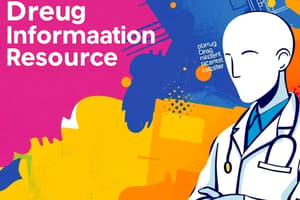Podcast
Questions and Answers
Which resource is known for providing a comprehensive overview of worldwide research output across a variety of fields?
Which resource is known for providing a comprehensive overview of worldwide research output across a variety of fields?
- LiverTox
- Embase
- Scopus (correct)
- Cochrane Library
What type of information does the Cochrane Database of Systematic Reviews primarily provide?
What type of information does the Cochrane Database of Systematic Reviews primarily provide?
- Historical medical records
- Primary research data from clinical trials
- Evidence for effective healthcare interventions (correct)
- Prescription guidelines for medications
What distinguishes Web of Science from other databases?
What distinguishes Web of Science from other databases?
- It is updated monthly.
- It provides only clinical trials data.
- It focuses solely on business and economic literature.
- It includes literature from over 150 disciplines. (correct)
What does LiverTox primarily focus on?
What does LiverTox primarily focus on?
What is the primary purpose of secondary sources of drug information?
What is the primary purpose of secondary sources of drug information?
Why might major medical and pharmacy school libraries lack access to Embase?
Why might major medical and pharmacy school libraries lack access to Embase?
Which of the following databases is NOT considered a secondary literature database?
Which of the following databases is NOT considered a secondary literature database?
How does PubMed differ from MEDLINE?
How does PubMed differ from MEDLINE?
What unique feature does Embase offer compared to MEDLINE?
What unique feature does Embase offer compared to MEDLINE?
Which of the following best describes the relationship between secondary and tertiary literature?
Which of the following best describes the relationship between secondary and tertiary literature?
Flashcards
Secondary Literature Databases
Secondary Literature Databases
Databases that compile and organize citations from original research articles.
MEDLINE
MEDLINE
A database with more than 31 million references on biomedical and life sciences articles.
EMBASE
EMBASE
A comprehensive database covering drugs, pharmacology, medical devices, and clinical medicine.
Non-MEDLINE Records
Non-MEDLINE Records
Signup and view all the flashcards
Citation
Citation
Signup and view all the flashcards
What is Scopus?
What is Scopus?
Signup and view all the flashcards
What is the Cochrane Library?
What is the Cochrane Library?
Signup and view all the flashcards
What is a systematic review?
What is a systematic review?
Signup and view all the flashcards
Describe LiverTox.
Describe LiverTox.
Signup and view all the flashcards
What is Web of Science?
What is Web of Science?
Signup and view all the flashcards
Study Notes
Drug Information Lecture 2
- Lecture by Dr. Sahar Badr
- Covered drug information resources including primary and secondary sources
- Secondary sources describe, discuss, review, analyze, evaluate, interpret, summarize information from primary research
- Act as an intermediary between primary and tertiary literature
- Connect researchers directly to original research articles and reviews
- Examples of secondary sources include indexing and abstracting sources
Sources of Drug Information Databases
- PubMed/MEDLINE: A journal citation database from the National Library of Medicine
- Provides over 31 million references to biomedical and life sciences journal articles (back to 1950)
- PubMed (since 1997), contains MEDLINE plus other citations (non-medical journals, e-books)
- Provides access to lots of biomedical literature databases, with MEDLINE being the largest
- Searches across all databases by default, but can be limited to MEDLINE only
- EMBASE: An established (1947) biomedical database
- Focuses on drugs, pharmacology, medical devices, clinical medicine, and relevant basic sciences
- Includes articles and journals indexed in MEDLINE, plus biomedical journals not covered by MEDLINE
- Includes 3,365 unique journals and 8,451 currently published journals
- May be costly for some libraries to access
- SCOPUS: A large abstract and citation database
- Includes peer-reviewed scientific journals, books, and conference proceedings
- Covers diverse fields (science, technology, medicine, social sciences, arts, and humanities)
- Contains 8,500 peer-reviewed journals in addition to MEDLINE citations
- Updated daily
- WEB OF SCIENCE: Extremely broad coverage
- Includes literature in agriculture, biological sciences, engineering, medical, life sciences, law, library sciences, architecture, dance, music, film, and theater
- Has over 8,500 major journals from 150 disciplines
- Updated weekly
Other Databases
- TOXNET (TOXLINE): Databases on toxicology, hazardous chemicals, and environmental health
- Cochrane Library: Provides evidence-based medicine databases
- Focuses on medical literature to support healthcare decision-making
- Includes systematic reviews and clinical trials
- Pillbox: Enables rapid identification of unknown solid-dosage medications (tablets/capsules) based on their physical characteristics (shape, size, color, imprint) and high-resolution images
- ClinicalKey: A medical resource, searchable through various interfaces
- Google Scholar: Widely used for research
- Web of Science: Another broad database
- ProQuest: Another comprehensive database
PubMed/MEDLINE Detail
- Provides access to detailed biomedical literature databases.
- The core aspect, MEDLINE, is the largest among those database resources.
- PubMed search terms automatically search all databases by default. However, one can search specifically only within MEDLINE
- PubMed is associated with the National Library of Medicine (NLM)
MeSH
- Medical Subject Headings (MeSH)
- A closed vocabulary used by MEDLINE for organizing literature
- Restricts searches to identified keywords
- Groups similar topics
- Example categories include Anatomy, Organisms, Diseases, Drugs, Techniques, and so on
- Hierarchical listing of terms from general to specific
- Offers a structured way to search medical literature
Advantages of Secondary Literature
- Quick access to primary literature
- Broad scope/concise information on various topics
- Generally, peer-reviewed and high quality journal sources
- Updated information via regular updates (e.g., weekly, monthly)
Disadvantages of Secondary Literature
- Lag time between publication and inclusion in secondary databases (days to weeks)
- Number of indexed journals is dependent on the specific database scope
- Requires proficiency in sifting/screening to find exact information.
How to Use Secondary Literature
- Databases are focused on various topics
- Linking keywords and terms
- Providing author, title, publication details, and often abstracts of the articles
Studying That Suits You
Use AI to generate personalized quizzes and flashcards to suit your learning preferences.




